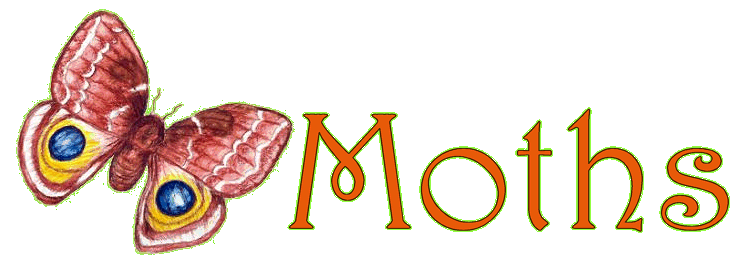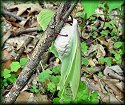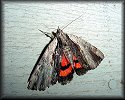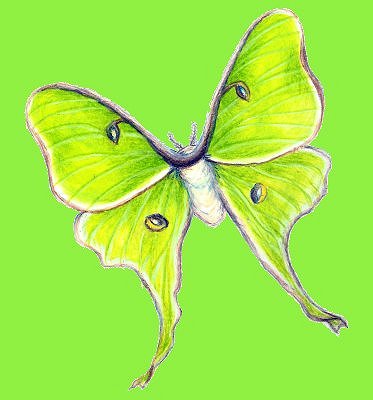

 Classification of Moths: Classification of Moths:
Moths belong to the Order Lepidoptera. They also can be broken down to the following Families listed below (and other Families not listed here) with the Genus and Species listed for each moth. Classification is one of those things that can change and be fine-tuned with more information and as research becomes available. So with that in mind, and needing to have some organization here, I have chosen to list the very basics only. Hopefully that is enough.
Please "click" all small photos to see larger photos.
This is a current work in progress, so please forgive missing information and the "less than organized" layout. I literally have hundreds of photos that I have taken and need to identify for this page. It is my goal for spring 2007.
Saturniidae Family

 |
This is a Luna Moth (Actias luna). This magnificent night flying moth is a member of the Saturniidae family of moths, and my personal favorite! The Saturniidae have reduced or absent tongues and cannot feed. They also hatch as beautiful flying creatures to find mates, reproduce, and then die. The Saturniidae is a family of over 1,000 species of the largest and most beautiful of the moths found worldwide. The Luna Moth is found throughout the USA to Mexico, and in southern Canada (though scarce). These Luna Moth pictures were taken in May of 2001. I just happened to be in the woods near the house taking pictures of wildflowers and glanced to my side, and there was this magnificent Luna Moth. He was so well camouflaged that I know I would not have seen him, had I not been right on top of him. The Luna Moth has a wingspan of up to 5 1/2 inches. This one had a wingspan of about 5 inches. I left this one as a found it, so it would breed. The second picture really shows how large bodied this moth is. I'm amazed to have seen one in the daylight!


|
This is a Cecropia Moth (Hyalophora cecropia). I did not take this picture, and I am sorry that I can't remember who did, but it is a great picture.
|

|




|
This is a Polyphemus Moth (Antheraea polyphemus). It has a wingspan of 4 to 5 inches. A very large moth, which flies at night, is found in the USA, southern Canada, and northern Mexico. The lower picture is a view of the belly and underside of the moth. The true colors are more like the back view. The upper wings have a "lemon" shape on each and the lower wings have a "lemon" shape in the eye spot. The third picture shows the caterpillar of the Polyphemus moth, though this particular one was hurt. The dime gives you an idea of its size. There are one to two broods per year. Though the caterpillar feeds on broad-leave trees and shrubs like the apple tree, the moth itself cannot feed. The Polyphemus moth is a another member of the Giant Silk or Emperor Moth family of Saturniidae, which have reduced or absent tongues and cannot feed. They also hatch as beautiful flying creatures to find mates, reproduce, and then die. The Saturniidae is a family of over 1,000 species of the largest and most beautiful of the moths found worldwide.



|
Another great member of the Satuniidae family of moths is the Promethea Moth (Callosamia promethea). A large (at 2 3/4 inches to 4 inches wide) and beautiful moth that flies at night. The males are mainly blackish brown and females are mainly bright reddish brown in color. These two were found together and are very different in color, so could be male and female. They are found from southern Canada to the southeastern USA. The males may fly in late afternoon, but females only fly at night. Like the other members of the Saturniidae, their caterpillars spin large cocoons to protect their pupae. These cocoons were once considered to be a possible source of raw silk, but cheap labor to unreel the cocoons proved impossible to find in North America. Which is good since they probably would have become extinct otherwise.
|



|
Another member of the Saturniidae family is the Io Moth (Automeris io). This is the first one I had ever seen, and for some reason I was expecting the Io to be as big as a Polyphemus or Luna. This one is about 2 to 3 1/4 inches wide. It appears to be a male and not a very fresh one as the wings are almost transparent. It was resting on the window screen and I coaxed it into the room for a picture, then I let it go. Its range is from southern Canada, through the USA and south to Mexico. The Io moth's caterpillar is pale green with branched stinging spines along its back. It feeds on a wide range of plants including birch, maize, and clover.



|


|



|
The Rosy Maple Moth (Dryocampa rubicunda) is my daughter's favorite moth. It looks like cotton candy to me. Despite the fact that these photos look like mug shots, the moth is very much alive, just very cooperative. It has a wingspan of 1 1/8 to 2 inches. Its host plants are the foliage of red and silver maples (no surprise there!) It is found in the eastern United States and southern Canada, west to the Great Plains. The Rosy Maple Moths caterpillars are called the "Green-striped Maple Worms" and can be so abundant that they will strip trees of all their foliage. Happily they have not done that to the maples around here.
|
Apatelodidae Family
I don't have any photos of the Spotted Apatelodes Moth (Apatelodes torrefacta), only pictures of the caterpillar. The description from the Northern Prairie Wildlife Research Center describes them as follows: "Body clothed with long yellow or white or gray setae; long black, or orange and black, medial lashes on dorsum of second and third thoracic and eighth abdominal segments. Black chevrons above spiracles. Ends of prolegs red. Food: wide range of trees and shrubs. Caterpillar: June to September; 2 generations." Well, I did photograph them in September, but I thought the "feet" looked more hot pink than red. And I really think they look like "Cousin It" from the Addams Family! I've included an underside view and a closeup of those feet below.


|


|
Lasiocampidae Family
This is the Eastern Tent Caterpillar Moth (Malacosoma americanum) with a wingspan of 1 1/2 to 2 inches. It is a member of the Lasiocampidae family of moths. There are about 1,500 species in the worldwide family. The Eastern Tent Caterpillar moth is found in the USA and southern Canada. The caterpillars can be found in "tents" that look like giant spider webs in trees in woodlands, hedgerows, or orchards. The caterpillars are very hairy and I think, cute. The moths have a distinctive, pale-edged band in the center of the forewing. This moth is also a night flyer.
|


|
Sphingidae Family
This Pink-spotted Hawkmoth (Agrius cingulata) is a member of the Sphingidae family of moths. There are about 1,000 members of this family found in the world. It ranges from South America and Central America to the southern part of the USA, Hawaii, and sometimes southern Canada. They are night fliers, and this one was just starting to wake up and test his wings when I photographed him. These moths feed on nectar with a long proboscis. Hawkmoths are also known as Sphinx moths because they have large larvae that hold their bodies erect, in a sphinx-like position. The Pink-spotted Hawkmoth has a wingspan of 3 1/4 inches to 4 1/4 inches. A pretty good sized moth. This hawkmoth is a strong flier and has been seen far at sea.
|


|



|
When I first took these pictures I wasn't even sure if it was a butterfly or a moth, but a "clue" in the description of the Small-eyed Sphinx Moth (Paonias myops) gave me the answer. It said, "...rests with a lobe of the hindwing extended before the forewing and, in the case of the male, with the abdomen curved upward." These moths can be found from southern Canada to Florida and west to the Rocky Mountains. They are found in deciduous woodlands, wooded habitats, and the suburbs. They have a wingspan of 2 to 2 1/2 inches. The larve prefer to feed on wild Cherry trees, but they also feed on Birch and other trees. I wish this moth would have opened his wings to show the "eyespot" that is found on the hind wings.
|
Arctiidae Family
This is a Virgin Tiger Moth (Gnammia virgo). It flies at night and has a wingspan of 1 3/4 to 2 1/4 inches. It starts out as a hairy black caterpillar that feeds on low growing plants like clover, plantain, and lettuce. (I'm guessing, not a friend of farmers.) It is found in Southeastern Canada, most of the USA, except the Far West. The lower picture is what one would look like with it's wings folded. The wing pattern is continued over the body to match the pattern. It is a member of the Arctiidae family with over 10,000 species found worldwide, with the greatest number found in the tropics.
|


|



|
The Banded Tussock Moth (Halysidota tessellaris) is also called the Pale Tiger Moth. I don't have a picture, but I do have pictures of the catapillar.
|
Lymantriidae Family
 |
The Gypsy Moth (Lymantria dispar) is a member of the Lymantriidae family. This family consists of 2,500 members worldwide. The moth has a wingspan of 1 1/2 to 2 1/2 inches. The males and females are very different in color and patterns. Also the males fly in the daytime, while the females do not fly at all and seldom are found far from where they emerged. The Gypsy moth is not native to North America, but was introduced in the mid-19th century with "silk production" in mind, but it escaped and is regarded as a pest, since the caterpillars can strip the foliage from a large area of forest.
|
Drepanidae Family

 |
Arched Hook-Tip Moths (Drepana arcuata) are a member of the Drepanidae family. And because of their very distinctive "hooked tips", easy to identify. The Drepanidae family includes about 800 species worldwide, except for Central and South America. It is a night flyer and is about 1 to 2 inches wide. The males and females are similiar in color, which can be pale yellowish white to orange-yellow with reddish-brown markings. This one looks particularly pale due to the flash used to photograph him. They are found from mid-spring to early autumn.
|
Noctuidae Family
 |
The Beautiful Wood Nymph Moth (Eudryas grata) is not only beautiful, but the name really is Beautiful Wood Nymph.
|
 |
I think this is a Ultronia Underwing Moth (Catocala ultronia) because it is a common Underwing and matches as close as I can see in the Moth book.
|

from Hanging Gardens
...The hopeful resurrection fern that withers with the heat
But joyously unfurls its fronds like leafy hands to greet
The welcome rain. Bright lichens cling against the rugged bark.
And moths, like little ghosts of thoughts, come flitting through the dark
To steal the honey from the blooms that cluster in the trees.
...
--- Don Blanding
|

References
- "Discovering Moths - Nighttime Jewels in Your Own Backyard" - John Himmelman
- "Butterflies and Moths" by David Carter
- "Butterfly Book" by Donald & Lillian Stokes & Ernest Williams
- "Eastern Forests" by Ann Sutton and Myron Sutton
- Reader's Digest "North American Wildlife"
- "Butterflies and Moths" by Robert T. Mitchell and Herbert S. Zim
- "Butterflies of North America" by Jim P. Brock & Kenn Kaufman
- "Moths of Eastern North America" by Charles V. Covell, Jr.
Back to Butterflies and Moths
Home
Site Map
Email at: dh @ naturehaven.com
(Take out the spaces and this email address will work!)
Please Read Guestbook ~~~ Please Sign Guestbook

Why more moths than butterflies here? They are easier to photograph, just turn on the porch light and wait a little while... But I'll try to track down a few more butterflies. And I have...
|


 Classification of Moths:
Classification of Moths:














































